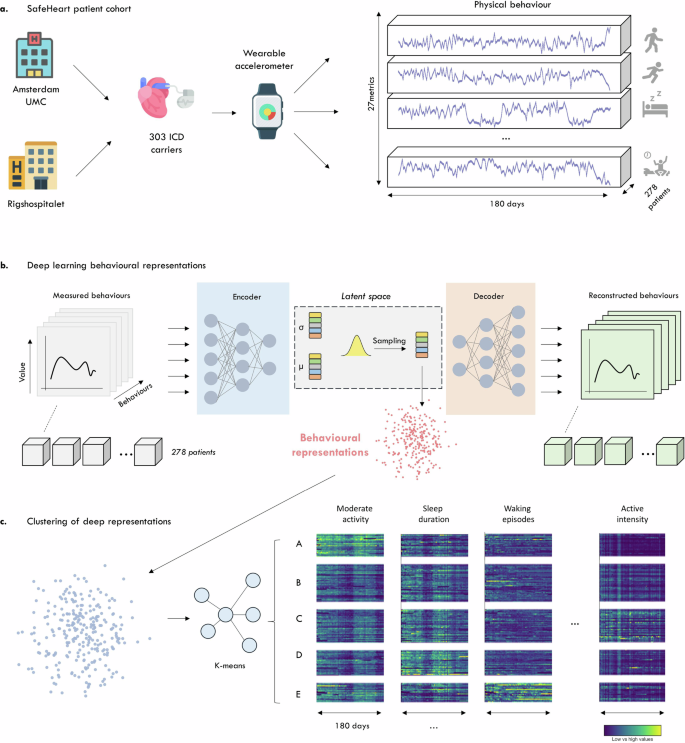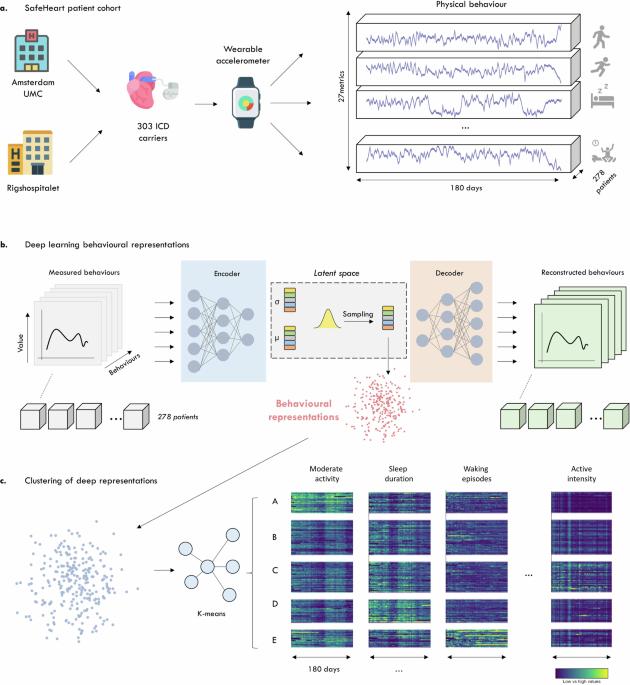Deep behavioural representation learning reveals risk profiles for malignant ventricular arrhythmias
IF 12.4
1区 医学
Q1 HEALTH CARE SCIENCES & SERVICES
引用次数: 0
Abstract
We aimed to identify and characterise behavioural profiles in patients at high risk of SCD, by using deep representation learning of day-to-day behavioural recordings. We present a pipeline that employed unsupervised clustering on low-dimensional representations of behavioural time-series data learned by a convolutional residual variational neural network (ResNet-VAE). Data from the prospective, observational SafeHeart study conducted at two large tertiary university centers in the Netherlands and Denmark were used. Patients received an implantable cardioverter-defibrillator (ICD) between May 2021 and September 2022 and wore wearable devices using accelerometer technology during 180 consecutive days. A total of 272 patients (mean age of 63.1 ± 10.2 years, 81% male) were eligible with a total sampling of 37,478 days of behavioural data (138 ± 47 days per patient). Deep representation learning identified five distinct behavioural profiles: Cluster A (n = 46) had very low physical activity levels and a disturbed sleep pattern. Cluster B (n = 70) had high activity levels, mainly at light-to-moderate intensity. Cluster C (n = 63) exhibited a high-intensity activity profile. Cluster D (n = 51) showed above-average sleep efficiency. Cluster E (n = 42) had frequent waking episodes and poor sleep. Annual risks of malignant ventricular arrhythmias ranged from 30.4% in Cluster A to 9.8% and 9.5% for Clusters D-E, respectively. Compared to low-risk profiles (D-E), Cluster A demonstrated a three-to-four fold increased risk of malignant ventricular arrhythmias adjusted for clinical covariates (adjusted HR 3.63, 95% CI 1.54–8.53, p < 0.001). These behavioural profiles may guide more personalised approaches to ventricular arrhythmia and SCD prevention.


深度行为表征学习揭示恶性室性心律失常的风险特征
我们的目标是通过对日常行为记录进行深度表征学习,识别并描述 SCD 高风险患者的行为特征。我们介绍了一个管道,该管道采用卷积残差变异神经网络(ResNet-VAE)学习的低维行为时间序列数据表示进行无监督聚类。研究使用了荷兰和丹麦两所大型三级大学中心开展的前瞻性观察性安全心脏研究的数据。患者在 2021 年 5 月至 2022 年 9 月期间接受了植入式心律转复除颤器 (ICD),并在连续 180 天内佩戴了使用加速度计技术的可穿戴设备。共有 272 名患者(平均年龄为 63.1 ± 10.2 岁,81% 为男性)符合条件,共获得 37,478 天的行为数据样本(每位患者 138 ± 47 天)。深度表征学习确定了五种不同的行为特征:群组 A(n = 46)的体力活动水平非常低,睡眠模式紊乱。B 组(n = 70)活动量大,主要是轻度至中度活动。C 组(n = 63)表现出高强度的活动特征。D 组(n = 51)的睡眠效率高于平均水平。E组(n = 42)频繁觉醒,睡眠质量差。恶性室性心律失常的年风险从 A 组的 30.4% 到 D-E 组的 9.8% 和 9.5% 不等。与低风险人群(D-E)相比,经临床协变量调整后,A 组患恶性室性心律失常的风险增加了三到四倍(调整后 HR 3.63,95% CI 1.54-8.53,p < 0.001)。这些行为特征可为室性心律失常和 SCD 的个性化预防方法提供指导。
本文章由计算机程序翻译,如有差异,请以英文原文为准。
求助全文
约1分钟内获得全文
求助全文
来源期刊

NPJ Digital Medicine
Multiple-
CiteScore
25.10
自引率
3.30%
发文量
170
审稿时长
15 weeks
期刊介绍:
npj Digital Medicine is an online open-access journal that focuses on publishing peer-reviewed research in the field of digital medicine. The journal covers various aspects of digital medicine, including the application and implementation of digital and mobile technologies in clinical settings, virtual healthcare, and the use of artificial intelligence and informatics.
The primary goal of the journal is to support innovation and the advancement of healthcare through the integration of new digital and mobile technologies. When determining if a manuscript is suitable for publication, the journal considers four important criteria: novelty, clinical relevance, scientific rigor, and digital innovation.
 求助内容:
求助内容: 应助结果提醒方式:
应助结果提醒方式:


